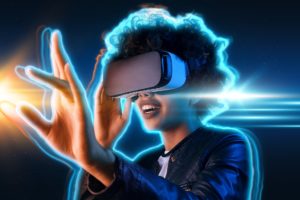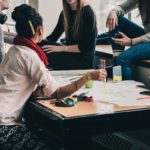Introduction to Virtual Reality in Education
Virtual reality, or VR, is a computer-generated simulation of a three-dimensional environment that can be interacted with in a seemingly real or physical way. VR can be experienced through the use of specialized equipment, such as a headset and gloves, or through the use of a smartphone or other device.
VR technology has been around for decades, but it has recently gained widespread attention and adoption in various fields, including education. In the classroom, VR can provide students with immersive and interactive learning experiences that are not possible with traditional teaching methods.
Compared to other forms of technology, such as augmented reality (AR) and mixed reality (MR), VR is unique in its ability to fully transport users into a virtual world. AR and MR, on the other hand, superimpose digital information onto the real world rather than creating a completely separate environment. While all three technologies have the potential to enhance learning and engagement, VR offers a level of immersion and interactivity that is not possible with AR and MR.
Is it really useful?
Benefits of Using Virtual Reality in the Classroom
There are many potential benefits to using VR in the classroom, including the following:
Enhanced experiential learning and hands-on exploration: VR allows students to explore and interact with virtual environments and objects in a way that is impossible in the real world. This can be particularly useful for subjects that require hands-on learning, such as science, technology, engineering, and math (STEM). For example, students can use VR to visit distant locations, perform experiments, and manipulate objects, all without leaving the classroom.
Increased student engagement and motivation: VR can be an engaging and exciting way for students to learn, particularly for those struggling with traditional teaching methods. The immersive nature of VR can capture students’ attention and keep them motivated to learn.
Development of critical thinking and problem-solving skills: VR experiences often require students to make decisions and solve problems to progress. This can help develop critical thinking and problem-solving skills, as well as creativity and innovation.
Development of social-emotional skills: VR can also teach social-emotional skills, such as communication, collaboration, and conflict resolution. For example, students can participate in virtual team-building activities or role-playing exercises.
Inclusive education and accommodation of diverse learning needs: VR can accommodate the diverse learning needs of students, including those with disabilities or language barriers. For example, VR can provide a visual or auditory representation of information, making it more accessible for students with learning differences. VR can also provide students with experiences that may be difficult or impossible for them to have in real life, such as field trips or simulations of dangerous situations.
Support for remote and hybrid learning environments: In the current climate, many schools are implementing remote or hybrid learning models. VR can be a valuable tool for supporting these environments, allowing students to participate in immersive learning experiences from anywhere.
Integrating Virtual Reality into the Classroom
Many virtual reality experiences can be used in education, including educational games and simulations, virtual field trips, and interactive lessons. Some popular educational VR platforms include Google Expeditions, Nearpod VR, and ClassVR.
To integrate VR into the classroom, teachers can start by identifying the learning objectives and standards they want to address. They can then select a VR experience that aligns with these objectives and incorporate it into their lesson plans. It is important to consider the age and ability level of the students, as well as the subject matter and goals of the lesson.
Assessing student learning and progress with VR can be done through various methods, including traditional methods such as quizzes and assessments, as well as more interactive methods like discussions and group projects. It is essential to regularly check in with students to ensure that they understand the material and making progress.
When using VR in the classroom, it is important to follow best practices to ensure a positive and practical learning experience. Some key considerations include:
Student safety and well-being: VR can be intense and disorienting for some students, so it is vital to ensure that students are physically and mentally prepared for the experience. Teachers should also provide breaks and monitor students for any signs of discomfort or distress.
Effectively using VR in the classroom: To get the most out of VR, teachers should clearly communicate the learning objectives and expectations to students beforehand and provide guidance and support during the VR experience. It is also important to debrief with students after the VR experience to review what they learned and how it relates to the lesson objectives.
Meta Quest 2 — Advanced All-In-One Virtual Reality Headset
*ad* (As an Amazon Associate I earn from qualifying purchases.)
Challenges and Limitations of Virtual Reality in Education
Like any technology, VR in education has challenges and limitations. Some common challenges teachers may encounter when using VR in the classroom include:
Cost and accessibility: VR equipment can be expensive, and not all schools have the budget or resources to purchase and maintain it. Additionally, not all students may have access to VR at home, which can create inequalities in learning experiences.
Limited content: While the availability of VR content for education is increasing, there is still a limited selection compared to other educational resources. This can limit the types of experiences and subjects covered with VR.
Technical issues: VR technology can be complex and prone to technical issues, such as glitches or compatibility issues. This can be frustrating for students and teachers and disrupt the learning experience.
To address these challenges, teachers can consider using VR in conjunction with other teaching methods and resources, such as traditional lectures or hands-on activities. Teachers can also seek out grants or fundraising opportunities to help cover the cost of VR equipment. Additionally, it can be helpful to have a plan in place for handling technical issues and to have backup resources available in case of any disruptions.
There are also some potential limitations to using VR in education, including:
Limited real-world application: While VR can provide immersive and interactive learning experiences, it may not always translate directly to real-world situations. This can be a particular concern for subjects like social studies or history, where it is important for students to understand the context and complexity of real-world events.
Distraction and overstimulation: VR can be highly engaging and immersive, but it can also be distracting for some students. It is important for teachers to balance the use of VR with other teaching methods to ensure that students are not overstimulated and can focus on learning.
Evaluating the Effectiveness of Virtual Reality in Education
To determine the impact of VR on student learning and engagement, teachers can use a variety of methods to evaluate its effectiveness. These methods can include:
Pre- and post-assessments: Teachers can give students assessments before and after a VR experience to measure their knowledge and understanding of the material.
Observations and feedback: Teachers can observe students during VR experiences and gather feedback from both students and their peers to see how they are responding to the material and how well they are interacting with it.
Student performance: Teachers can track students’ grades and other performance indicators, such as participation and engagement, to see if there is any improvement after using VR in the classroom.
There are several factors to consider when evaluating the effectiveness of VR in the classroom, including the quality and alignment of the VR experience with the learning objectives, the engagement and motivation of the students, and the overall impact on student learning and performance. It is also important to consider the classroom context and any other factors that may have influenced the results.
Future Directions for Virtual Reality in Education
As VR technology continues to advance, there are many exciting possibilities for its use in education. Emerging technologies, such as haptic feedback and 5G connectivity, have the potential to further enhance the immersive and interactive nature of VR experiences.
One potential direction for VR in education is virtual reality classrooms, where students and teachers can participate in online classes and interact with each other and the material in a virtual environment. This could potentially expand access to education and allow students to participate in learning experiences that may be difficult or impossible to have in person.
Another direction for VR in education is using VR to prepare students for the future. VR can simulate real-world scenarios and challenges, such as problem-solving and decision-making, that students may encounter in their future careers. It can also expose students to new technologies and concepts that will likely shape the future.
To stay ahead of the curve and prepare for the future of VR in education, teachers can continue to learn about emerging technologies and best practices for using VR in the classroom. They can also stay connected with other teachers and educational organizations to share ideas and resources.
Conclusion and Final Thoughts
Virtual reality has the potential to enhance student learning and development in several ways, including experiential learning, increased engagement and motivation, and the development of critical thinking and problem-solving skills. While there are challenges and limitations to using VR in education, with careful planning and consideration, teachers can effectively incorporate VR into their lesson plans and curriculum.
As VR technology continues to evolve, it will be important for teachers to stay informed and adapt to new developments to maximize the potential of VR in the classroom. With the right approach, VR can be a powerful tool for enriching student learning and preparing them for the future.
Please comment and share if you found this helpful!
THANK YOU! 😊
Read about more instructional strategies!










